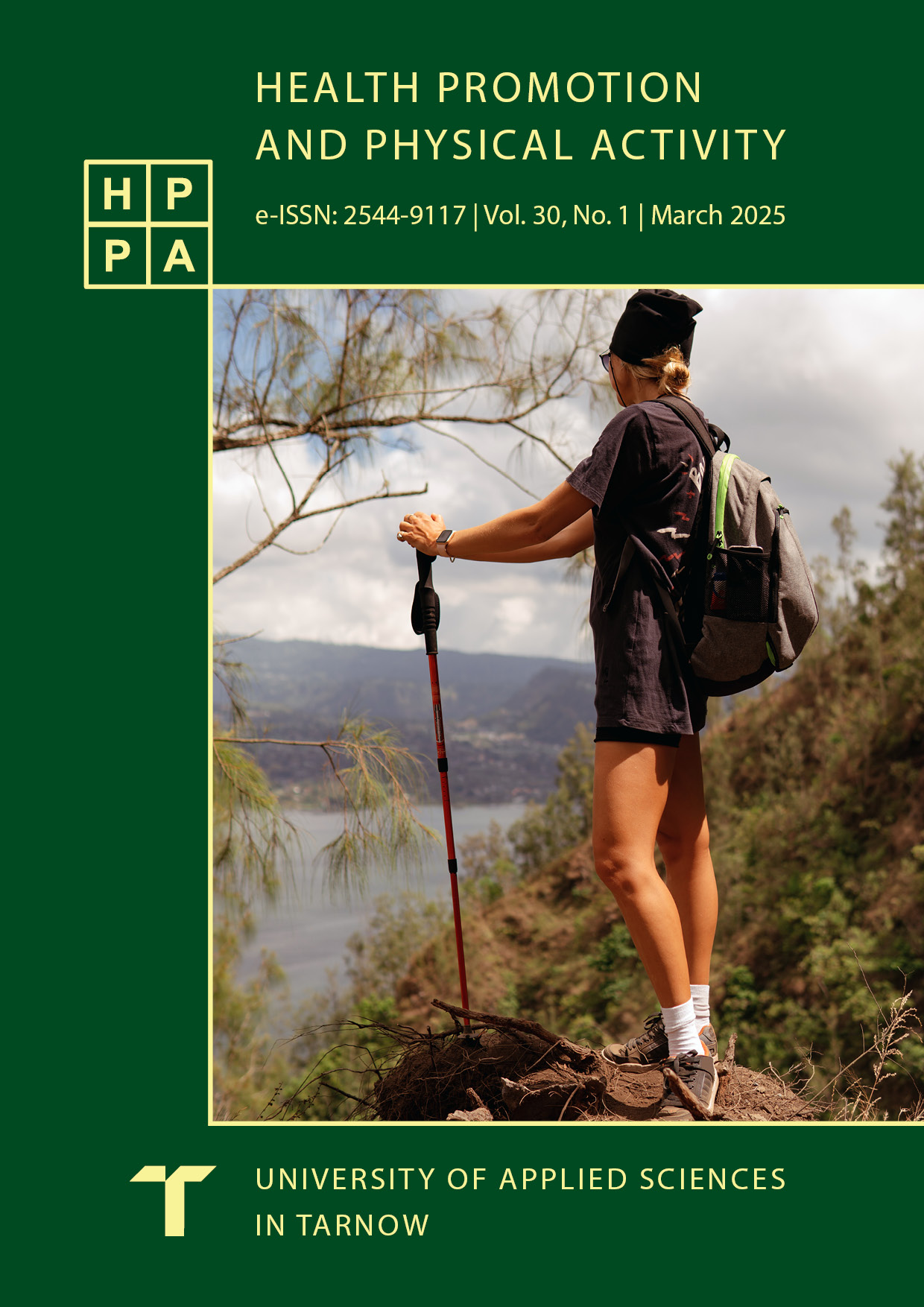Hiking fatalities on Angels Landing Trail — factors identified from Zion National Park
DOI:
https://doi.org/10.55225/hppa.641Keywords:
hiking, fatality, Angels Landing Trail, Zion National ParkAbstract
Hiking is a popular outdoor activity with approximately 45 million participants in the United States each year. The growing popularity of hiking has given rise to an increasing number of hiking-related deaths. Within the U.S. State of Utah and Zion National Park, the Angels Landing Trail has been identified as a trail recording a high number of hiking deaths. The popular trail ascends 454 m and is lined with slippery edges and steep drop-offs along its 8 km roundtrip trail. The most minor mistakes will easily result in death. Utilizing a case study approach, this study identified unsafe hiking behavior, pre-existing health conditions, the physical environment, and the social environment as primary contributing factors in hiking fatalities on the trail. In the 1950s – 1960s guard rails were added to the trail, in 2010 a total of 55 meters of posts and chains were installed along the trail, and in 2022 Zion National Park instituted a permit system aimed at reducing overcrowding and improving the hiking experience. Since 2022, only a single hiking death has been recorded on the trail. Further monitoring of the trail is warranted so that of the number of fatalities and the factors contributing to any death can be compared from before and after the implementation of the permit system.
Downloads
References
Bohne M, Abendroth-Smith J. Effects of hiking downhill using trekking poles while carrying external loads. Med Sci Sport Exerc. 2007;39(1):177-183. doi: 10.1249/01.mss.0000240328.31276.fc. DOI: https://doi.org/10.1249/01.mss.0000240328.31276.fc Google Scholar
Heggie TW, Heggie TM. Dead men hiking: Case studies from the American wilderness. Med Sport. 2012;16(3):118-121. doi: 10.5604/17342260.1011392. DOI: https://doi.org/10.5604/17342260.1011392 Google Scholar
Chrusch A, Cavin M. Survey of musculoskeletal injuries, prehike conditioning, and on-trail injury prevention strategies self-reported by long-distance hikers on the Appalachian Trail. Wilderness Environ Med. 2021;32(3):322-331. doi: 10.1016/j.wem.2021.04.004. DOI: https://doi.org/10.1016/j.wem.2021.04.004 Google Scholar
Heggie TW, Küpper T. Pediatric and adolescent injury in wilderness and extreme environments. Res Sports Med. 2018;26(sup1):186-198. doi: 10.1080/15438627.2018.1438280. DOI: https://doi.org/10.1080/15438627.2018.1438280 Google Scholar
Flaherty GT. What lies beneath – preventing accidental freshwater drowning in tourists. J Travel Med. 2018;25(1):1-2. doi: 10.1093/jtm/tay038. DOI: https://doi.org/10.1093/jtm/tay038 Google Scholar
Sleet DA, Balaban V. Travel medicine: Preventing injuries to children. Am J Lifestyle Med. 2012;7(2):121-129. doi: 10.1177/15598276124573. DOI: https://doi.org/10.1177/1559827612457322 Google Scholar
Guse CE, Cortés LM, Hargarten SW, Hennes HM. Fatal injuries of US citizens abroad. J Travel Med. 2007;14(5):279-287. doi: 10.1111/j.1708-8305.2007.00133.x. DOI: https://doi.org/10.1111/j.1708-8305.2007.00133.x Google Scholar
Heggie TW, Amundson ME. Dead men walking: Search and rescue in U.S. National Parks. Wild Environ Med. 2009;20(3):244-249. doi: 10.1580/08-WEME-OR-299R.1. DOI: https://doi.org/10.1580/08-WEME-OR-299R.1 Google Scholar
Heggie TW, Heggie TM. Saving tourists: The status of emergency medical services in California’s National Parks. Travel Med Infect Dis. 2009;7(1):19-24. doi: 10.1016/j.tmaid.2008.12.002. DOI: https://doi.org/10.1016/j.tmaid.2008.12.002 Google Scholar
Heggie TW, Heggie TM, Kliewer C. Recreational travel fatalities in US National Parks. J Travel Med. 2008;15(6):404-411. doi: 10.1111/j.1708-8305.2008.00235.x. DOI: https://doi.org/10.1111/j.1708-8305.2008.00235.x Google Scholar
Heggie TW, Heggie TM. Search and rescue trends and the emergency medical service workload in Utah’s National Parks. Wild Environ Med. 2008;19(3):164-171. doi: 10.1580/07-WEME-OR-178.1. DOI: https://doi.org/10.1580/07-WEME-OR-178.1 Google Scholar
Brown PM, Gentry C, Yao Q. Historical and current fire regimes in ponderosa pine forests at Zion National Park, Utah: Restoration of pattern and process after a century of fire exclusion. Forest Ecol Manage. 2019;445:1-12. doi: 10.1016/j.foreco.2019.04.058. DOI: https://doi.org/10.1016/j.foreco.2019.04.058 Google Scholar
Ripple WJ, Beschta RL. Linking a cougar decline, trophic cascade, and catastrophic regime shift in Zion National Park. Biol Conserv. 2006;133(4):397-408. doi: 10.1016/j.biocon.2006.07.002. DOI: https://doi.org/10.1016/j.biocon.2006.07.002 Google Scholar
Stephanides SL, Vohra T. Injury patterns and first aid training among canyoneers. Wild Eviron Med. 2007;18(1):16-19. doi: 10.1580/1080-6032(2007)18[16:ipafat]2.0.co;2. DOI: https://doi.org/10.1580/1080-6032(2007)18[16:IPAFAT]2.0.CO;2 Google Scholar
Mace BL, Marquit JD, Bates SC. Visitor assessment of the mandatory alternative transportation system at Zion National Park. Environ Manage. 2013;52(5):1271-1285. doi: 10.1007/s00267-013-0164-z. DOI: https://doi.org/10.1007/s00267-013-0164-z Google Scholar
Boulware DR, Forgey WW, Martin WJ. Medical risks of wilderness hiking. Amer J Med. 2003;114(4):288-293. doi: 10.1016/s0002-9343(02)01494-8. DOI: https://doi.org/10.1016/S0002-9343(02)01494-8 Google Scholar
Chamarro A, Fernandez-Castro J. The perception of causes of accidents in mountain sports: A study based on the experience of victims. Acc Anal Prev. 2009;4(1)1:197-201. doi: 10.1016/j.aap.2008.10.012. DOI: https://doi.org/10.1016/j.aap.2008.10.012 Google Scholar
Stephens BD, Diekema DS, Klein EJ. Recreational injuries in Washington State National Parks. Wilderness Environ Med. 2005;16(4):192-197. doi: 10.1580/1080-6032(2005)16[192:riiwsn]2.0.co;2. DOI: https://doi.org/10.1580/1080-6032(2005)16[192:RIIWSN]2.0.CO;2 Google Scholar
Gardner TB, Hill DR. Illness and injury among long-distance hikers on the Long Trail, Vermont. Wilderness Environ Med. 2002;13(2):131-134. doi: 10.1580/1080-6032(2002)013[0131:iaiald]2.0.co;2. DOI: https://doi.org/10.1580/1080-6032(2002)013[0131:IAIALD]2.0.CO;2 Google Scholar
Ela GK. Epidemiology of wilderness search and rescue in New Hampshire, 1999–2001. Wilderness Environ Med. 2004;15(1):11-17. doi: 10.1580/1080-6032(2004)015[0011:eowsar]2.0.co;2. DOI: https://doi.org/10.1580/1080-6032(2004)015[0011:EOWSAR]2.0.CO;2 Google Scholar
Trayers FJ. Wilderness preventive medicine. Wilderness Environ Med. 2004;15(1):1-3. doi: 10.1580/1080-6032(2004)015[0001:wpm]2.0.co;2. DOI: https://doi.org/10.1580/1080-6032(2004)015[0001:WPM]2.0.CO;2 Google Scholar
Girasek DC, Marschall JS, Pope D. Understanding hikers who approached a hazardous river in Yosemite National Park. Inj Prev. 2016;22(2):110-116. doi: 10.1136/injuryprev-2015-041625. DOI: https://doi.org/10.1136/injuryprev-2015-041625 Google Scholar
Heggie TW, Jorgenson JD. Two death in two days: A case report of mountaineering fatalities on Mount Rainier. Med Sport. 2010;14(1):24-27. doi: 10.2478/v10036-010-0007-4. DOI: https://doi.org/10.2478/v10036-010-0007-4 Google Scholar
Heggie TW, Heggie TM. Viewing lava safely: An epidemiology of hiker injury and illness in Hawaii Volcanoes National Park. Wilderness Environ Med. 2004;15(2):77-81. doi: 10.1580/1080-6032(2004)015[0077:vlsaeo]2.0.co;2. DOI: https://doi.org/10.1580/1080-6032(2004)015[0077:VLSAEO]2.0.CO;2 Google Scholar
Spano SJ, Hile AG, Jain R, Stalcup PR. The epidemiology and medical morbidity of long-distance backpackers on the John Muir Trail in the Sierra Nevada. Wilderness Environ Med. 2018;29(2):203-210. doi: 10.1016/j.wem.2018.02.006. DOI: https://doi.org/10.1016/j.wem.2018.02.006 Google Scholar
Stoltzfus KB, Naylor D, Cattermole T, Ankeney A, Mount R, Chang R, Gibson CA. Blood pressure changes while hiking at moderate altitudes: A prospective cohort study. Int J Environ Res Public Health. 2020;17(21):7978. doi: 10.3390/ijerph17217978. DOI: https://doi.org/10.3390/ijerph17217978 Google Scholar
Heggie TW. Search and rescue in Alaska’s national parks. Travel Med Infect Dis. 2008; 6(6):355-361. doi: 10.1016/j.tmaid.2008.07.002. DOI: https://doi.org/10.1016/j.tmaid.2008.07.002 Google Scholar
Windsor JS, Firth PG, Grocott MP, Rodway GW, Montgomery HE. Mountain mortality: A review of deaths that occur during recreational activities in the mountains. Postgrad Med J. 2009;85(1004): 316-321. doi: 10.1136/pgmj.2009.078824. DOI: https://doi.org/10.1136/pgmj.2009.078824 Google Scholar
Burtscher M, Philadelphy M, Likar R. Sudden cardiac death during mountain hiking and downhill skiing. N Engl J Med. 1993;329(23):1738-1739. doi: 10.1056/NEJM199312023292315. DOI: https://doi.org/10.1056/NEJM199312023292315 Google Scholar
Pellicer-García B, Antón-Solanas I, Ramón-Arbués E, García-Moyano L, Gea-Caballero V, Juárez-Vela R. Risk of falling and associated factors in older adults with a previous history of falls. Int J Environ Res Public Health. 2020;17(11):4085. doi: 10.3390/ijerph17114085. DOI: https://doi.org/10.3390/ijerph17114085 Google Scholar
Faulhaber M, Ruedl G, Schneider F, Walter D. Characteristics of victims of fall-related accidents during mountain hiking. Int J Environ Res Public Health. 2020;17(3):1115. doi: 10.3390/ijerph17031115. DOI: https://doi.org/10.3390/ijerph17031115 Google Scholar
Küpper T, Heggie T, Kühn C, Schwarz U, Schöffl V, Morrison A, Kühn J. The epidemiology of injuries and the first aid knowledge of via ferrata climbers in the European Alps. Health Prom Phys Act. 2024;26(1):10–25. doi: 10.55225/hppa.571. DOI: https://doi.org/10.55225/hppa.571 Google Scholar
Küpper T, Apel C, Bertsch D, Cerfontaine C, van der Giet M, van der Giet S, Graß M, Haunolder M, Heussen NM, Hundt N, Jäger J, Kühn C, Morrison A, Timmermann L, Wernitz K, Gieseler U, Schöffl V, Musiol S. Trekking with non-cardiovascular preexisting health conditions at altitude. Health Prom Phys Act. 2024;28(3),29–40 doi: 1055225/hppa607. DOI: https://doi.org/10.55225/hppa.607 Google Scholar
Downloads
Published
How to Cite
Issue
Section
License
Copyright (c) 2025 Travis W. Heggie, Amanda Hawkes, Thomas Küpper

This work is licensed under a Creative Commons Attribution-ShareAlike 4.0 International License.









